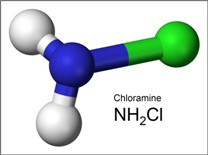
Chloramine and Your HealthSaturday, November 1, 2014 - by Water2Drink
In the United States, Canada, and other first-world
countries, we are fortunate to have national and state regulations enacted to
protect our public water supplies. These
agencies, along with your local water provider, are tasked with delivering to the
public clean, disinfected water in order to prevent the spread of disease. The most common disinfectants used today are
chlorine and chloramine. While these
disinfectants are entirely necessary, even when used within federal regulation
guidelines, there still are serious health issues associated with routinely ingesting
such substances.
Chlorine is highly effective for the disinfection of water. However, challenges occur in the disinfection
process because chlorine can react with organic materials in the water,
especially from surface water sources. This
results in what is called “disinfection byproducts,” and these byproducts, such
as Trihalomethanes (TTHM), have been identified as #carcinogens and can lead to
serious illness.
Some water supply companies have made the switch from #chlorine
to chloramine. Chloramine (also referred
to as monochloramine) is a combination of chlorine and ammonia. While chloramine
is less likely to produce disinfection byproducts, it is a less effective
disinfectant than chlorine. It can also change
the chemical properties of water, which can foster corrosion and cause pipes to
leach lead and copper into the water.
Both chlorine and #chloramine are toxic to fish, aquatic
animals, reptiles, and amphibians. While
chlorine may dissipate from water if left to sit out for a few days, chloramine
cannot be removed in this manner.
Chloramine cannot be removed by either boiling or by the #distillation
process. In addition, chloramine vapors and disinfection byproducts can accumulate
in indoor air. The only effective way of
removing these disinfectants from your water is through point-of-use filtration
with a high quality carbon filter.
The Multipure family of water filtration systems reduces
chlorine and chloramine to the lowest possible levels, and these reductions are
tested and certified according to NSF/ANSI Standards. While many water filters on the market make
claims as to the reduction of disinfection chemicals and by-products, many are
not effective in reducing chloramine. You must insist on seeing #NSF testing and
certification of these claims. #Multipure
drinking water systems lead the industry in contaminant reduction, and this
includes the harsh chemicals used to disinfect your water.
|
|
Tweet
|
Leave a Comment


 Comments
Comments